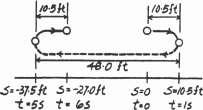Solution Manual for Engineering Mechanics
Dynamics 13th Edition by Hibbeler ISBN
0132911272 9870132911276
Full link download: Solution Manual: https://testbankpack.com/p/solution-manual-for-engineering-mechanicsdynamics-13th-edition-by-hibbeler-isbn-0132911272-9780132911276/


A baseball is thrown downward from a 50-ft tower with an initial speed of 18 ft>s. Determine the speed at which it hits the ground and the time of travel
SOLUTION
v2 = v2 + 2a (s - s ) 2 1 c 2 1
v2 = (18)2 + 2(32 2)(50 - 0)
v2 = 59 532 = 59.5 ft>s
v2 = v1 + ac t
59 532 = 18 + 32 2(t)
t = 1 29 s
Ans Ans.

When a train is traveling along a straight track at 2 m/s, it v begins to accelerate at a = 160 v-42 m>s2 , where v is in m/s Determine its velocity v and the position 3 s after the acceleration.


From approximately what floor of a building must a car be dropped from an at-rest position so that it reaches a speed of 80 7 ft>s 155 mi>h2 when it hits the ground? Each floor is 12 ft higher than the one below it. (Note: You may want to remember this when traveling 55 mi>h )
The car must be dropped from the 9th floor. Ans.

Traveling with an initial speed of 70 km>h, a car accelerates at 6000 km>h2 along a straight road How long will it take to reach a speed of 120 km>h? Also, through what distance does the car travel during this time?
SOLUTION
v = v1 + ac t
120 = 70 + 6000(t)
t = 8 33(10-3) hr = 30 s
v 2 = v 2 + 2 a (s - s )
(120)2 = 702 + 2(6000)(s - 0)
s = 0 792 km = 792 m Ans

A bus starts from rest with a constant acceleration of 1 m>s2 Determine the time required for it to attain a speed of 25 m>s and the distance traveled.

SOLUTION
Kinematics
A stone A is dropped from rest down a well, and in 1 s another stone B is dropped from rest. Determine the distance between the stones another second later
sA = 64.4 ft

s
sB = 16.1 ft
¢s = 64.4 - 16 1 = 48 3 ft
A bicyclist starts from rest and after traveling along a straight path a distance of 20 m reaches a speed of 30 km/h. Determine his acceleration if it is constant Also, how long does it take to reach the speed of 30 km/h?
SOLUTION
v2 = 30 km>h = 8.33 m>s
v2 = v2 + 2 a (s - s ) 2 1 c 2 1

(8 33)2 = 0 + 2 ac (20 - 0)
ac = 1 74 m>s2
v2 = v1 + ac t
8 33 = 0 + 1 74(t)
t = 4 80 s
A particle moves along a straight line with an acceleration of a = 5>(3s1>3 + s5>2) m>s2 , where s is in meters
Determine the particle’s velocity when s = 2 m, if it starts from rest when s = 1 m Use Simpson’s rule to evaluate the integral.

If it takes 3 s for a ball to strike the ground when it is released from rest, determine the height in meters of the building from which it was released. Also, what is the velocity of the ball when it strikes the ground?



The position of a particle along a straight line is given by s = (1.5t3 - 13.5t2 + 22.5t) ft, where t is in seconds. Determine the position of the particle when t = 6 s and the total distance it travels during the 6-s time interval. Hint: Plot the path to determine the total distance traveled
SOLUTION
Position: The position of the particle when t = 6 s is
Total DistanceTraveled: The velocity of the particle can be determined by applying Eq 12–1.

The times when the particle stops are
The position of the particle at t = 0 s,1 s and 5 s are

If a particle has an initial velocity of v0 = 12 ft>s to the right, at s0 = 0, determine its position when t = 10 s, if a = 2 ft>s2 to the left

Determine the time required for a car to travel 1 km along a road if the car starts from rest, reaches a maximum speed at some intermediate point, and then stops at the end of the road The car can accelerate at 1.5 m>s2 and decelerate at 2 m>s2
SOLUTION

Using formulas of constant acceleration:

Tests reveal that a normal driver takes about 0 75 s before he or she can react to a situation to avoid a collision. It takes about 3 s for a driver having 0 1% alcohol in his system to do the same If such drivers are traveling on a straight road at 30 mph (44 ft>s) and their cars can decelerate at 2 ft>s2 , determine the shortest stopping distance d for each from the moment they see the pedestrians Moral: If you must drink, please don’t drive!
SOLUTION
Stopping Distance: For normal driver, the car moves a distance of d¿ = vt = 44(0 75) = 33.0 ft before he or she reacts and decelerates the car The stopping distance can be obtained using Eq 12–6 with s0 = d¿ = 33.0 ft and v = 0
+ 2(-2)(d - 33 0)
For a drunk driver, the car moves a distance of d¿ = vt = 44(3) = 132 ft before he or she reacts and decelerates the car The stopping distance can be obtained using Eq 12–6 with s0 = d¿ = 132 ft and v = 0
+ 2(-2)(d - 132) d

A car is to be hoisted by elevator to the fourth floor of a parking garage, which is 48 ft above the ground. If the elevator can accelerate at 0 6 ft>s2 , decelerate at 0.3 ft>s2 , and reach a maximum speed of 8 ft>s, determine the

time to make the lift, starting from rest and ending at rest

A train starts from rest at station A and accelerates at 0.5 m>s2 for 60 s Afterwards it travels with a constant velocity for 15 min It then decelerates at 1 m>s2 until it is brought to rest at station B. Determine the distance between

A particle travels along a straight line such that in 2 s it moves from an initial position sA = +0.5 m to a position sB = -1 5 m Then in another 4 s it moves from sB to sC = +2.5 m. Determine the particle’s average velocity and average speed during the 6-s time interval

SOLUTION
¢s = (sC - sA) = 2 m

sT = (0.5 + 1.5 + 1.5 + 2 5) = 6 m
t = (2 + 4) = 6 s
vavg = ¢s = 2 = 0 333 m>s Ans. t 6
sT 6 (vsp)avg = t = 6 = 1 m>s Ans
The acceleration of a particle as it moves along a straight line is given by a = 12t - 12m>s2 , where t is in seconds. If s = 1 m and v = 2 m>s when t = 0, determine the particle’s velocity and position when t = 6 s. Also, determine the total distance the particle travels during this time period
SOLUTION
v dv = L 2
t (2 t - 1) dt L 0
v = t2 - t + 2
s t
ds = L 1 (t2 - t + 2) dt L 0
s = 1 t31 t2 + 2 t + 1 3 2
When t = 6 s,
v = 32 m>s
s = 67 m

Ans. Ans.
Since v Z 0 then
d = 67 - 1 = 66 m Ans.
A freight train travels at v = 6011 - e-t2 ft>s, where t is the

elapsed time in seconds Determine the distance traveled in three seconds, and the acceleration at this time

A particle travels to the right along a straight line with a velocity v = [5>14 + s2] m>s, where s is in meters Determine its position when t = 6 s if s = 5 m when t = 0.
SOLUTION
ds = 5
dt 4 + s s (4 + s) ds =
L 5

t 5 dt L 0
4 s + 0 5 s2 - 32.5 = 5 t
When t = 6 s,
s2 + 8 s - 125 = 0
Solving for the positive root
s = 7 87 m Ans.
The velocity of a particle traveling along a straight line is v = (3t2 - 6t) ft>s, where t is in seconds. If s = 4 ft when t = 0, determine the position of the particle when t = 4 s. What is the total distance traveled during the time interval t = 0 to t = 4 s? Also, what is the acceleration when t = 2 s?
SOLUTION
Position: The position of the particle can be determined by integrating the kinematic equation ds = v dt using the initial condition s = 4 ft when t = 0 s.Thus,
The velocity of the particle changes direction at the instant when it is momentarily brought to rest. Thus,
The position of the particle at t = 0 and 2 s is

Using the above result, the path of the particle shown in Fig a is plotted From this figure,

If the effects of atmospheric resistance are accounted for, a falling body has an acceleration defined by the equation
a = 9 81[1 - v2(10-4)] m>s2 , where v is in m>s and the positive direction is downward. If the body is released from rest at a very high altitude, determine (a) the velocity when
t = 5 s, and (b) the body’s terminal or maximum attainable velocity (as t : q).
SOLUTION
Velocity: The velocity of the particle can be related to the time by applying Eq 12–2.
(+T) dt = dv a t v dv dt =
L 0 L 0 9 81[1(0 01v)2]
1 v dv v dv
t = 9.81 c L 2(1 + 0.01v) + L 2(1 - 0 01v) d
9 81t = 50lna 1 + 0 01v b
1 - 0.01v
100(e0 1962t - 1)
v = e0 1962t + 1 (1)
a) When t = 5 s, then, from Eq (1)
v =



0 1962t
100[e0 1962(5) - 1]
e0 1962(5) + 1 = 45.5 m>s Ans.
b) If t : q, - 1 : 1 Then, from
e0 1962t + 1 Eq (1)
vmax = 100 m>s
Ans.
The position of a particle on a straight line is given by

s = 1t3 - 9t2 + 15t2 ft, where t is in seconds. Determine the position of the particle when t = 6 s and the total distance it travels during the 6-s time interval. Hint: Plot the path to determine the total distance traveled
SOLUTION
s = t3 - 9t2 + 15t
v = ds dt = 3t2 - 18t + 15
v = 0 when t = 1 s and t = 5 s
t = 0, s = 0
t = 1 s, s = 7 ft
t = 5 s, s = -25 ft
t = 6 s, s = -18 ft
sT = 7 + 7 + 25 + (25 - 18) = 46 ft
Two particles A and B start from rest at the origin s = 0 and move along a straight line such that aA = (6t - 3) ft>s2 and aB = (12t2 - 8) ft>s2 , where t is in seconds Determine the distance between them when t = 4 s and the total distance each has traveled in t = 4 s
SOLUTION
Velocity:The velocity of particles A and B can be determined using Eq 12-2. dvA = aAdt
vB t dvB = 0 (12t2 - 8)dt L 0 vB = 4t3 - 8t
The times when particle A stops are
3t2 - 3t = 0 t = 0 s and = 1 s
The times when particle B stops are
4t3 - 8t = 0 t = 0 s and t = 22 s
Position:The position of particles A and B can be determined using Eq 12-1.


A particle is moving along a straight line such that its velocity is defined as v = (-4s2) m>s, where s is in meters. If s = 2 m when t = 0, determine the velocity and acceleration as functions of time



A sphere is fired downwards into a medium with an initial speed of 27 m>s If it experiences a deceleration of a = (-6t) m>s2 , where t is in seconds, determine the distance traveled before it stops
SOLUTION
Velocity: v0 = 27 m>s at t0 = 0 s.Applying Eq. 12–2,we have A + TB dv = adt
v L27 dv = t -6tdt L 0
v = A27 - 3t2 B m>s (1)
At v = 0, from Eq. (1) 0 = 27 - 3t2 t = 3 00 s
Distance Traveled: s0 = 0 m at t0 = 0 s Using the result v = 27 - 3t2 and applying Eq. 12–1,we have
A + TB ds = vdt s ds = L 0
t A27 - 3t2 B dt 0
s = A27t - t3 B m (2)
At t = 3 00 s, from Eq (2)


s = 27(3 00) - 3 003 = 54.0 m Ans

When two cars A and B are next to one another, they are
traveling in the same direction with speeds vA and vB , respectively. If B maintains its constant speed, while A begins to decelerate at aA , determine the distance d
the cars at the instant A stops
SOLUTION



A particle is moving along a straight line such that when it is at the origin it has a velocity of 4 m>s. If it begins to decelerate at the rate of a = 1-1 5v1>22 m>s2 , where v is in m>s, determine the distance it travels before it stops.

A particle travels to the right along a straight line with a velocity v = [5>14 + s2] m>s, where s is in meters

Determine its deceleration when s = 2 m
Solutions Manual for Engineering Mechanics Dynamics 13th Edition by Hibbeler
Full clear download (no error formatting) at : https://downloadlink.org/p/solutions-manual-forengineering-mechanics-dynamics-13th-edition-by-hibbeler/ engineering mechanics dynamics rc hibbeler 13th edition pdf free download
engineering mechanics dynamics 14th edition hibbeler pdf
engineering mechanics dynamics 13th edition solutions manual pdf free
engineering mechanics dynamics 12th edition pdf
engineering mechanics statics and dynamics 13th edition
hibbeler dynamics 13th edition solutions pdf
engineering mechanics dynamics rc hibbeler 13th edition solution manual pdf
engineering mechanics dynamics pdf
